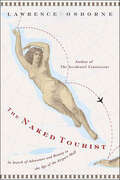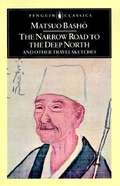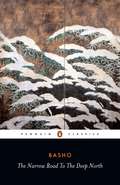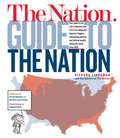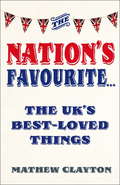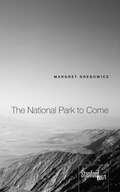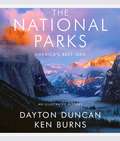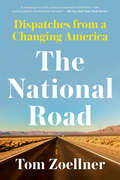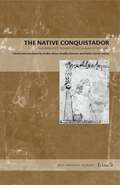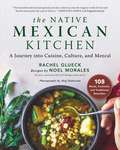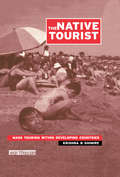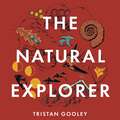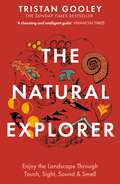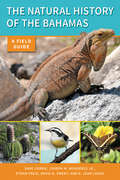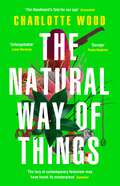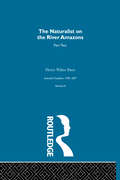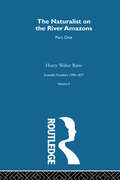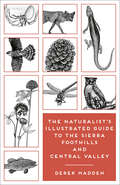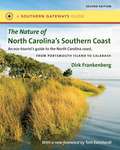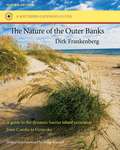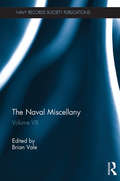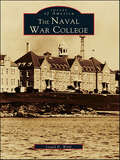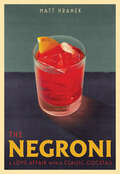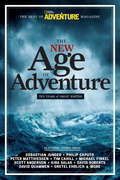- Table View
- List View
The Naked Tourist: In Search of Adventure and Beauty in the Age of the Airport Mall
by Lawrence OsborneFrom the theme resorts of Dubai to the jungles of Papua New Guinea, a disturbing but hilarious tour of the exotic east—and of the tour itselfSick of producing the bromides of the professional travel writer, Lawrence Osborne decided to explore the psychological underpinnings of tourism itself. He took a six-month journey across the so-called Asian Highway—a swathe of Southeast Asia that, since the Victorian era, has seduced generations of tourists with its manufactured dreams of the exotic Orient. And like many a lost soul on this same route, he ended up in the harrowing forests of Papua, searching for a people who have never seen a tourist. What, Osborne asks, are millions of affluent itinerants looking for in these endless resorts, hotels, cosmetic-surgery packages, spas, spiritual retreats, sex clubs, and "back to nature" trips? What does tourism, the world's single largest business, have to sell? A travelogue into that heart of darkness known as the Westernmind, The Naked Tourist is the most mordant and ambitious work to date from the author of The Accidental Connoisseur, praised by The New York Times Book Review as "smart, generous, perceptive, funny, sensible."
The Narrow Road to the Deep North and Other Travel Sketches
by Nobuyuki Yuasa Matsuo BashMatsuo Bash(1644 - 1694), later known as Matsuo Chemon Munefusa,was the most famous poet of the Edo period in Japan. In his haiku poems, Basho described the natural world with great simplicity and delicacy of feeling.
The Narrow Road to the Deep North and Other Travel Sketches
by Matsuo Basho'It was with aweThat I beheldFresh leaves, green leaves,Bright in the sun'When the Japanese haiku master Basho composed The Narrow Road to the Deep North, he was an ardent student of Zen Buddhism, setting off on a series of travels designed to strip away the trappings of the material world and bring spiritual enlightenment. He writes of the seasons changing, the smell of the rain, the brightness of the moon and the beauty of the waterfall, through which he sensed the mysteries of the universe. These writings not only chronicle Basho's travels, but they also capture his vision of eternity in the transient world around him.Translated with an Introduction by Nobuyuki Yuasa
The Nation Guide to the Nation
by Richard LingemanThe essential lifestyle guide for the millions of progressives from coast to coast, "The Nation Guide to the Nation" can help left-of-center types find left-leaning shops, cultural institutions, and gathering places in their own hometowns and on the road.
The Nation's Favourite: A Book of the UK's Best-loved Things
by Mathew ClaytonIn the last 100 years mankind has split the atom, walked on the moon and broken the sound barrier but... we haven't got any better at making biscuits. The nation's favourite biscuit, McVitie's Chocolate Digestive, was first baked in 1892. This is just one of the fascinating facts you will find in The Nation's Favourite. What is the UK's favourite karaoke song, or wedding first dance song? What is our favourite cereal, painkiller, pet or garden tool? The Nation's Favourite brings together 220 lists which provide the answers to these questions and many more. The result is amusing, surprising and reveals a fascinating picture of the tastes and habits of the UK population.
The National Park to Come
by Margret GrebowiczHistorians of wilderness have shown that nature reserves are used ideologically in the construction of American national identity. But the contemporary problem of wilderness demands examination of how profoundly nature-in-reserve influences something more fundamental, namely what counts as being well, having a life, and having a future. What is wellness for the citizens to whom the parks are said to democratically belong? And how does the presence of foreigners threaten this wellness? Recent critiques of the Wilderness Act focus exclusively on its ecological effects, ignoring the extent to which wilderness policy affects our contemporary collective experience and political imagination. Tracing the challenges that migration and indigenousness currently pose to the national park system and the Wilderness Act, Grebowicz foregrounds concerns with social justice against the ecological and aesthetic ones that have created and continue to shape these environments.
The National Parks: An Illustrated History
by Ken Burns Dayton DuncanThe companion volume to the new Ken Burns film: a magnificently illustrated history of the American National Park System. In a rich, deeply informative narrative, Dayton Duncan and Ken Burns examine how each new park was brought into the system.
The National Road: Dispatches From a Changing America
by Tom ZoellnerThis collection of "eloquent essays that examine the relationship between the American landscape and the national character" serves to remind us that despite our differences we all belong to the same land (Publishers Weekly).“How was it possible, I wondered, that all of this American land––in every direction––could be fastened together into a whole?”What does it mean when a nation accustomed to moving begins to settle down, when political discord threatens unity, and when technology disrupts traditional ways of building communities? Is a shared soil enough to reinvigorate a national spirit?From the embaattled newsrooms of small town newspapers to the pornography film sets of the Los Angeles basin, from the check–out lanes of Dollar General to the holy sites of Mormonism, from the nation’s highest peaks to the razed remains of a cherished home, like a latter–day Woody Guthrie, Tom Zoellner takes to the highways and byways of a vast land in search of the soul of its people.By turns nostalgic and probing, incisive and enraged, Zoellner’s reflections reveal a nation divided by faith, politics, and shifting economies, but––more importantly––one united by a shared sense of ownership in the common land.
The Native Conquistador: Alva Ixtlilxochitl’s Account of the Conquest of New Spain (Latin American Originals #10)
by Bradley Benton Amber Brian Pablo García LoaezaFor many years, scholars of the conquest worked to shift focus away from the Spanish perspective and bring attention to the often-ignored voices and viewpoints of the Indians. But recent work that highlights the “Indian conquistadors” has forced scholars to reexamine the simple categories of conqueror and subject and to acknowledge the seemingly contradictory roles assumed by native peoples who chose to fight alongside the Spaniards against other native groups. The Native Conquistador—a translation of the “Thirteenth Relation,” written by don Fernando de Alva Ixtlilxochitl in the early seventeenth century—narrates the conquest of Mexico from Hernando Cortés’s arrival in 1519 through his expedition into Central America in 1524. The protagonist of the story, however, is not the Spanish conquistador but Alva Ixtlilxochitl’s great-great-grandfather, the native prince Ixtlilxochitl of Tetzcoco. This account reveals the complex political dynamics that motivated Ixtlilxochitl’s decisive alliance with Cortés. Moreover, the dynamic plotline, propelled by the feats of Prince Ixtlilxochitl, has made this a compelling story for centuries—and one that will captivate students and scholars today.
The Native Conquistador: Alva Ixtlilxochitl’s Account of the Conquest of New Spain (Latin American Originals #10)
by Bradley Benton Amber Brian Pablo García LoaezaFor many years, scholars of the conquest worked to shift focus away from the Spanish perspective and bring attention to the often-ignored voices and viewpoints of the Indians. But recent work that highlights the “Indian conquistadors” has forced scholars to reexamine the simple categories of conqueror and subject and to acknowledge the seemingly contradictory roles assumed by native peoples who chose to fight alongside the Spaniards against other native groups. The Native Conquistador—a translation of the “Thirteenth Relation,” written by don Fernando de Alva Ixtlilxochitl in the early seventeenth century—narrates the conquest of Mexico from Hernando Cortés’s arrival in 1519 through his expedition into Central America in 1524. The protagonist of the story, however, is not the Spanish conquistador but Alva Ixtlilxochitl’s great-great-grandfather, the native prince Ixtlilxochitl of Tetzcoco. This account reveals the complex political dynamics that motivated Ixtlilxochitl’s decisive alliance with Cortés. Moreover, the dynamic plotline, propelled by the feats of Prince Ixtlilxochitl, has made this a compelling story for centuries—and one that will captivate students and scholars today.
The Native Mexican Kitchen: A Journey into Cuisine, Culture, and Mezcal
by Rachel Glueck Noel MoralesA Deep Dive into the Complex and Vibrant Native Culture that is the Bedrock of Mexican Cuisine, with Over One Hundred Recipes, Including Moles, Pozoles, Chiles en Nogada, and More Mexican cuisine is ubiquitous in the American dining scene, yet it remains far removed from its roots. The Native Mexican Kitchen is an homage to the indigenous peoples and their culinary and cultural traditions that create Mexican cuisine, elevating it beyond Americanized tacos and tequila. With recipes by Mexican chef Noel Morales—born of Aztec and Omec blood, grandson to a mezcalero, and raised by native dancers—The Native Mexican Kitchen offers its readers the ability to recreate the flavors of centuries-old dishes in a modern kitchen. Morales shares well-known plates such as birria and barbacoa, and beloved market foods like tlayudas and tacos al pastor, as well as a few of his own vegetarian and seafood creations. Signature mezcal cocktails and decadent desserts adorn these pages, while the Medicinales section includes teas, tinctures, and baths of traditionally used herbs for a variety of ailments, such as colds, muscle tension, and infertility. Author Rachel Glueck provides rare access and insight into a Mexico that few foreigners or nationals see today, leading you through indigenous festivals with masked dancers, bountiful market places, and sacred pilgrimage sites. Unwrap the philosophies and customs of Mexico&’s native communities and discover the depth of this magical country and how you can welcome it into your own kitchen. Personal stories of mezcaleros, traditional cooks, and native healers are accentuated by 130 stunning photographs and are woven through with mouth-watering recipes. With pages bursting with color, culture, and wisdom, you&’ll discover a Mexico you never knew existed.
The Native Tourist: Mass Tourism Within Developing Countries
by Krishna B GhimireDomestic tourism in developing countries is rapidly outstripping international tourism and could soon involve ten times the numbers. This is an examination of the numbers involved, their profile, behaviour, impacts and the relevant policy responses. The volume looks at the impacts of local mass tourism in various socio-economic and environmental contexts and on diverse social groups. It provides analysis and overviews of seven of the main countries involved in Asia, Africa and Latin America.
The Natural Explorer: A must-have for all nature lovers - perfect reading for your summer adventures
by Tristan Gooley**From the bestselling author of THE WALKER'S GUIDE TO OUTDOOR CLUES AND SIGNS and HOW TO READ WATER, The Sunday Times Book Of The Year**Tristan Gooley, author of THE NATURAL NAVIGATOR demonstrates how it is possible to connect profoundly with the lands we travel through, even from the comfort of your living room. In THE NATURAL EXPLORER he combines the work of the some of the most insightful travellers of the past two thousand years with his own experience.The most rewarding travel experiences do not depend on our destination or the length of our journey, but on our levels of awareness. A short walk can compare with an epic journey, when we take the time to focus on the things that dramatically enrich each journey.Exploration is no longer about hardship, long distances, or even venturing beyond the borders of your own home. It is about celebrating the sense of connection and discovery that is possible in all our travels.
The Natural Explorer: Understanding Your Landscape
by Tristan GooleyTristan Gooley, author of THE NATURAL NAVIGATOR demonstrates how it is possible to connect profoundly with the lands we travel through. In THE NATURAL EXPLORER he combines the work of the some of the most insightful travellers of the past two thousand years with his own experience.From the author of How To Read Water, The Sunday Times Book Of The Year. The most rewarding travel experiences do not depend on our destination or the length of our journey, but on our levels of awareness. A short walk can compare with an epic journey, when we take the time to focus on the things that dramatically enrich each journey.Exploration is no longer about hardship or long distances, it is about celebrating the sense of connection and discovery that is possible in all our travels.
The Natural History of The Bahamas: A Field Guide
by Dave Currie Joseph M. Wunderle Jr. Ethan Freid David N. Ewert D. Jean LodgeTake this book with you on your next trip to the Bahamas or the Turks and Caicos Islands or keep it close to hand in your travel library. The Natural History of the Bahamas offers the most comprehensive coverage of the terrestrial and coastal flora and fauna on the islands of the Bahamas archipelago, as well as of the region's natural history and ecology. Readers will gain an appreciation for the importance of conserving the diverse lifeforms on these special Caribbean islands. A detailed introduction to the history, geology, and climate of the islands. Beautifully illustrated, with more than seven hundred color photographs showcasing the diverse plants, fungi, and animals found on the Bahamian Archipelago.
The Natural Way of Things: From the Booker Prize-shortlisted author of Stone Yard Devotional
by Charlotte WoodFrom the author of the Booker Prize-shortlisted novel Stone Yard Devotional'Savage: think Atwood in the outback'PAULA HAWKINS'An unforgettable reading experience'LIANE MORIARTY'Ferocious . . . recalls the early Elena Ferrante'NPR'A masterpiece'GUARDIAN'Devastating' ECONOMISTShe hears her own thick voice deep inside her ears when she says, 'I need to know where I am.'The man stands there, tall and narrow, hand still on the doorknob, surprised.He says, almost in sympathy, 'Oh, sweetie. You need to know what you are.'"Two women awaken from a drugged sleep to find themselves imprisoned in a broken-down property in the middle of a desert.Strangers to each other, they have no idea where they are or how they came to be there with eight other girls, their heads shaved, guarded by two inept yet vicious jailers.Doing hard labour under a sweltering sun, the prisoners soon learn what links them: in each girl's past is a sexual scandal with a powerful man.They pray for rescue but as the hours turn into days and the days into weeks and months, it becomes clear only the girls can rescue themselves.Praise for Charlotte Wood's Stone Yard DevotionalShortlisted for the Booker Prize 2024 'A beautiful, mature work that does not flinch from life'SUNDAY TIMES'A transfixing novel'FINANCIAL TIMES'A book about what it means to be good: simply and with great humility, it asks the big questions, leaving the reader feeling kinder, more brave, enlarged'ANNE ENRIGHT'I have rarely been so absorbed by a novel . . . A powerful, generous book'GUARDIAN
The Naturalist on the River Amazons Vol II: Scientific Travellers VI
by Henry Walter BatesThe Naturalist on the River Amazons is a record of adventures, habits of animals, sketches of Brazilian and Indian life and aspect of nature under the Equator, during the author's eleven years of travel, in two volumes this is the second.
The Naturalist on the River Amazons Volume I: Scientific Travellers 1790-1877 Volume V
by Henry Walter BatesThe Naturalist on the River Amazons is a record of adventures, habits of animals, sketches of Brazilian and Indian life and aspect of nature under the Equator, during the author's eleven years of travel, in two volumes, this is the first.
The Naturalist's Illustrated Guide to the Sierra Foothills and Central Valley
by Derek MaddenThis guide to the wildlife and vegetation of California’s Central Valley and Foothills Regions features more than seven hundred detailed line drawings.California’s San Joaquin and Sacramento Valleys and the nearby Sierra Nevada Foothills are host to abundant, varied, and often surprising plants and wildlife. This fully illustrated guide pairs over seven hundred meticulous line drawings with descriptions of the birds, mammals, amphibians, reptiles, fishes, invertebrates, plants, and fungi that make this diverse and beautiful region their home. Like a ranger-led nature walk, each species receives a lively overview; readers will learn about freshwater jellyfish, mushrooms that decompose railroad ties, handstanding spotted skunks, salt-shedding pickleweed—not to mention insects. Every write-up not only contains fun facts but also conveys a sense of the complex connections and interactions that sustain life in a unique place. Previously published as Magpies and Mayflies (Heyday, 2005), The Naturalist’s Illustrated Guide to the Sierra Foothills and Central Valley features updated scientific and common names, and a full redesign.
The Nature of North Carolina's Southern Coast
by Tom Earnhardt Dirk FrankenbergFor some years, The Nature of North Carolina's Southern Coast has stood as an essential resource for all who treasure our coastal environment. In this book, Dirk Frankenberg describes the southern coast's beaches, inlets, and estuaries and instructs readers in the responsible exploration and enjoyment of some of North Carolina's most precious natural areas. From Ocracoke Inlet to the South Carolina border, this field guide provides a close-up look at a complex ecosystem, highlighting the processes that have shaped, and continue to shape, North Carolina's southern coast. Frankenberg identifies over 50 different areas of interest along 180 miles of coastline and presents images to help identify natural processes, plants, and plant communities. In addition, he addresses threats to these fragile coastal areas and possible solutions for these threats. Tom Earnhart's new foreword brings the book up to date, helping us appreciate why a deeper understanding of this environment is crucial to its continued enjoyment.Southern Gateways Guide is a registered trademark of the University of North Carolina Press
The Nature of the Outer Banks
by Dirk Frankenberg Betsy BennettNorth Carolina's Outer Banks are in constant motion, responding to weather, waves, and the rising sea level. Beaches erode, sometimes taking homes or sections of highway with them into the surf; sand dunes migrate with the wind; and storms open new inlets and dump sand in channels and sounds. A classic guide, The Nature of the Outer Banks describes these dynamic forces and guides visitors to sites where they can see these phenomena in action. In the first section of the book, Dirk Frankenberg highlights three major processes on the Outer Banks: the rising sea level, movement of sand by wind and water, and stabilization of sand by plant life. In the second section, he provides a mile-by-mile field guide to the northern Banks, and in the final section, he alerts readers to the dangers of overdevelopment on the Outer Banks. In a new foreword for this edition, Betsy Bennett documents the ever-more-critical situation of these shifting sands.Southern Gateways Guide is a registered trademark of the University of North Carolina Press
The Naval Miscellany: Volume VIII (Navy Records Society Publications)
by Brian ValeBrian Vale is a naval historian with degrees from Keele and King’s College London. A life-long member of the Society for Nautical Research and the Navy Records Society, he has long specialised in Anglo-South American maritime history. His books include Independence or Death! British sailors and Brazilian Independence, A Frigate of King George, The Audacious Admiral Cochrane and Cochrane in the Pacific: Fortune and Freedom in Spanish America.
The Naval War College (Images of America)
by Lionel D. WyldExplore the history of one of the nation's most prestigious service schools in The Naval War College. It was appropriate that the U.S. Navy's pioneer training station and principal graduate college be established at Newport. Known as "The City by the Sea," Newport, Rhode Island, has a long history of maritime activity. As far back as the colonial period, Newport Harbor and Narragansett Bay have always been safe and deep havens for naval as well as commercial shipping. In 1883, Commodore Stephen B. Luce established the Naval Training Station on Coaster's Harbor Island in Newport, which became the forerunner of the modern recruit stations for enlisted men in the U.S. Navy. The next year, in 1884, Luce established the Naval War College, the first professional naval education center of its kind in the world. It soon became the U.S. Navy's premier institution for professional studies of warfare, international law, and statesmanship relating to war and peace. Among others, Luce brought to the college Capt. Alfred Thayer Mahan, the naval historian whose book, The Influence of Sea Power Upon History, 1600-1783, and other works influenced naval thought throughout the world.
The Negroni: A Love Affair with a Classic Cocktail
by Matt HranekA CENTURY AGO THE COCKTAIL ACHIEVED PERFECTION when, according to legend, Count Camillo Negroni asked his bartender in Florence to stiffen an Americano by replacing the soda water with gin. The world never looked back. With its cosmically simple 1:1:1 ratio, its balance of bitter and sweet, its pleasant kick, its aura of sophistication, the Negroni has bewitched cocktail lovers ever since. Perhaps none more so than Matt Hranek, who intones this love song to his favorite drink and offers a curated collection of recipes, both the classic and dozens of variations, deviations, and delicious reinterpretations.
The New Age of Adventure
by John RasmusRasmus (founding editor-in-chief, National Geographic Adventure magazine) presents a collection of 25 of the best nonfiction stories from the first decade of Adventure magazine. Written by 20 well-known, prize-winning American journalists, war correspondents, travel writers, naturalists, and novelists, the stories describe experiences from all parts of the globe and in all types of situations, from Sebastian Junger's opening account of a trip to Afghanistan to interview guerilla leader Ahmad Shah Massoud, to Philip Caputo's experience tracking Kenya's man-eating Tsavo lions, Scott Anderson's tale of a coming-of-age road trip across Europe and Asia, and Gretel Ehrlich's story of the nomadic reindeer herders in northwestern Russia. No subject index. Annotation c2010 Book News, Inc. , Portland, OR (booknews. com)
